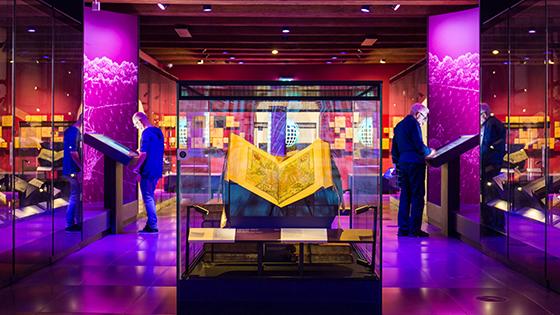Before visiting the Scheepvaartmuseum (Maritime Museum) I looked up their opening times on their website. Almost all Dutch museums can be found on the internet, either with their own website or on websites about the area they are located. These websites show information to possible visitors about the museum. Some websites offer more than just information about how to visit the museum. The Scheepvaartmuseum has a website with information about their collection. Part of the collection is visible on their website.[1] This allows both non-visitors and visitors to access information from the collection online. These websites are open-access and don’t differentiate between non-visitors and visitors. The information is available for everyone.
During a visit to the Scheepvaartmuseum you will find multiple digital tools in their exhibitions. These tools can be used to play games, be creative, but most importantly access information. An example of tools which let visitors access more information can be found in the ‘De Atlassen’ exhibition, where atlases are on display. A screen allows you to browse through an atlas and look at maps. This allows the visitor to discover more about the maps and atlases that are on display in the museum. Digital tools are attractive for visitors, because it allows them to explore information during their visit and get more in-depth information about topics that interest them. In the Scheepvaartmuseum there is a lot of information available inside these digital tools. Most museum visitors won’t be able to discover it all during one visit.

Accessing information at home
Museums can also choose to use these digital tools to give visitors the possibility to receive more information after their visit, so they don’t have to view it all during their museum visit or are able to access it again. This information is limited to people who visited the museum. During a visit to a museum the visitor can choose to read more information at home. The Scheepvaartmuseum in Amsterdam is one of the museums that use this technique. In their exhibition about atlases mentioned above visitors have the possibility to send information about their favorite map from an atlas to themselves. They will receive an email with a link to access a picture of the page they selected from an atlas.[2] These pictures aren’t accessible in the digital collection of the Scheepvaartmuseum. The possibility to send people information after their visit is also used in other museums.
Nederlands Instituut voor Beeld en Geluid (Netherlands Institute for Sound and Vision) uses a ring that visitors carry throughout the museum. This ring is scanned at places where videos and pictures can be made. By entering an email address, these photos and videos are sent to the visitor after they visited the museum.[3] Nederlands Openluchtmuseum (Netherlands Open Air Museum) also offers visitors information to take home. Visitors get a token, hanging on a small cord which can be used as a bracelet, when they enter the ‘Canon’-exhibition in the museum. With this token they can play games and access information in the exhibition. It’s also used to collect data about the visitor to project them in a certain time. People are shown what their lives would be like in another time, using their current height, ages, living situation, gender, etc. This information is saved and not asked again at every screen corresponding to a certain time. There are places where you can scan this token to receive more information at home about topics from the ‘Canon’. At the end of the exhibition the token can be linked to an email address, to receive this information. This allows visitors to access information at home.
Possibilities
These examples show different kinds of information sent to visitors after a visit to a museum. It shows sending information to visitors after their visit can be interesting for various museums for different reasons. The information is sent to the visitors by email, which also gives them a reminder about the visit to the museum. It can also be a souvenir, for example the picture of a map received after a visit to the Scheepvaartmuseum or pictures made during a visit to the Beeld en Geluid. This can be shared with other people or on social media, which means sending this information to visitors can also be of promotional value sometimes. The main possible advantage of using this technique, is in my opinion the possibility for visitors to access more information than they could view during their visit or to access information again that they found interesting during their visit to a museum.
The email from the Scheepvaartmuseum only contains a link to a picture of a map from one of the atlases, which the visitor selected. I however think it would be beneficial to add information about the atlas to the page containing this picture. Visitors can’t access this information about atlases easily outside of the museum. If information about the maps or atlases was added to the page showing the picture, visitors would be able to read more at home about the collection of the Scheepvaartmuseum. This would make it possible for visitors to visit information from the exhibition again or read more information than they could during their visit.
[1] https://www.hetscheepvaartmuseum.nl/collectie/digitale-collectie
[2] Example of a link to a page showing a map of a selected atlas: http://hetscheepvaartmuseum.mcw.nl/pages/atlas/5_56
[3] https://beeldengeluid.nl/bezoek/wat-er-te-doen/de-beeld-en-geluid-experience